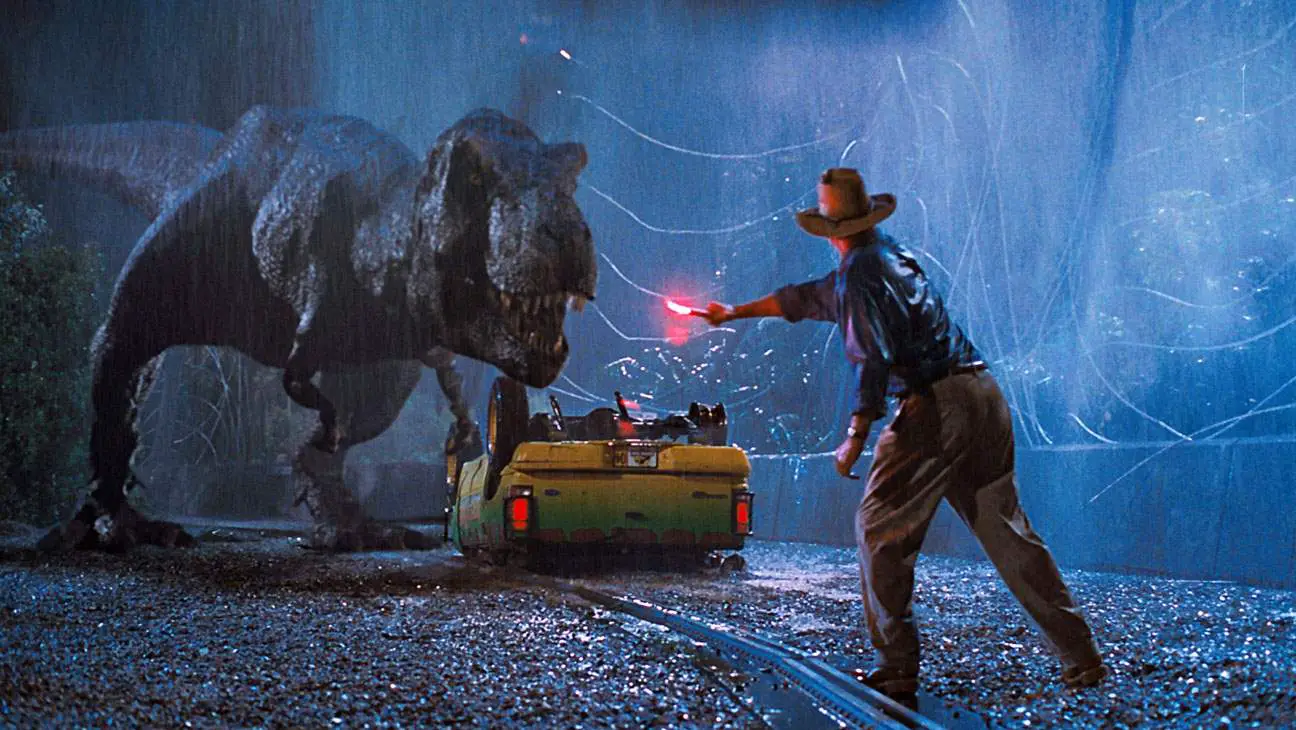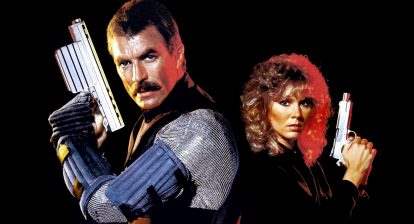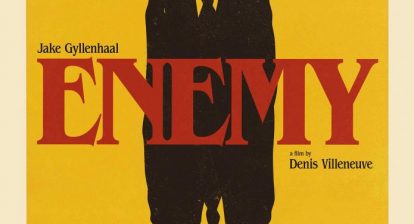Horror is evolving as a genre. Although your local multiplex is still peppered with the usual contenders, look a bit closer at the schedule and you’ll find the latest drama, thriller, or crime offering is closer to horror than you might expect. In this bi-weekly series, Joey Keogh presents a film not generally classified as horror and argues why it exhibits the qualities of a great flight flick, and therefore deserves the attention of fans as an example of Not Quite Horror. With Jurassic World just around the corner, this week we revisit the flick that started it all: Spielberg’s seminal and still-terrifying Jurassic Park.
Those of a certain age will vividly recall the first time they saw Jurassic Park. At five years old, I was much too young for it and, much like Batman Returns–which I watched through my fingers the previous year–Spielberg’s dinosaurs had a lasting effect on me. To put it mildly, I was terrified; of the massive, earth-shattering T-Rex, the sneaky velociraptors, and that other, weird dinosaur that spat goo and screeched and had a head that kind of looked like a flower. Arguably the greatest family horror movie of all time, Jurassic Park is genetically designed to scare the pants off children. But, as adults, we know better than to be frightened of a giant, animatronic T-Rex, right?
First and foremost, that massive, fully-functional beast is the stuff of nightmares–even nowadays nothing really compares to it. Created by VFX wizard Stan Winston and his visionary team of experts, the T-Rex was the only fully-built dinosaur used in the flick (the rest comprised mostly of moveable tops, bottoms, and bit parts like claws or feet). With a moveable head and, more importantly, set of jaws, it boasted an earth-shattering roar comprised of the sounds of several, real-life deadly animals. As the villain/hero of the movie, it’s a force to be reckoned with but, true to form, Spielberg knew exactly what he had and teased us with it first.
Think of that first glimpse of its claw slipping over the fence structure, or of the camera slowly moving up, up, up to capture its full form as it chomps down on a poor little goat. The T-Rex was fully-realised, slaved over for months and perfected to the point that, if he wished, Spielberg could’ve just given us two hours of it wandering around and occasionally bending to eat something and we still would’ve been transfixed. Its considerable size is even joked about as an “objects in the rear-view mirror may appear closer than they are” warning becomes visible as it chases a fleeing jeep.
Speaking of which, the CGI in Jurassic Park is often better than the modern equivalent. Yes, that first shot of the brontosaurus is a little smudgy, but it’s still more convincing than the majority of today’s multiplex-stuffing dross. Spielberg called on SFX geniuses such as Michael Lantieri and Phil Tippett (who pioneered the “Go Motion” technique) to make the wide shots of the dinos as realistic as possible, while the team at ILM were charged with combining all of the various elements in post. 22 years later, their work holds up exceptionally well. In fact, when the first trailer for Jurassic World dropped, it was the as-yet-unfinished CGI that had most fans up in arms.In spite of boasting some of the greatest VFX in history, Spielberg makes use of a trick he honed in Jaws by teasing us with suggestion before outright showing us anything. The horrifying opening sequence, in which a random worker is savaged by a raptor, sets the tone perfectly for what’s to come. It only takes some disturbing noises and the grasp of a desperate hand to set the wheels in motion. Later, Dr. Grant gives a nightmare-inducing speech to a disbelieving kid about what a raptor would do if it got its claws into him, again setting the scene.
Then, upon reaching the park, we’re privy to a raptor feeding during which, again, nothing is shown with just the noises and movements in the paddock and the expressions of those watching enough to put us on edge. The raptors are some of the most fearsome villains in cinema, and it’s easy to forget that they were often just guys in suits, operating the heads like giant puppets. Although it sounds hokey, this is a remarkably effective technique, particularly during the infamous kitchen sequence. Much like the T-Rex, the way the raptors move their heads is key and its an effect, much like the smooth scales of their skin, that cannot be replicated properly with CGI.
 Jurassic Park is a family’ movie, rated PG in the UK and PG-13 in the US, but it was considered borderline to the point that the BBFC warned cinema-goers to be vigilant as: “This film contains sequences which may be particularly disturbing to younger children or children of a sensitive disposition”. It was only the second time a stipulation of this type was used in conjunction with the release of a PG-rated movie, and it was noted at the time that Spielberg wouldn’t let his own kids watch Jurassic Park because it was too intense. Likewise, Michael Medved, a stringent critic of Hollywood violence, remarked at the time that any parent who thought it an appropriate film to show their children is “guilty of unconscionable child abuse”.
Jurassic Park is a family’ movie, rated PG in the UK and PG-13 in the US, but it was considered borderline to the point that the BBFC warned cinema-goers to be vigilant as: “This film contains sequences which may be particularly disturbing to younger children or children of a sensitive disposition”. It was only the second time a stipulation of this type was used in conjunction with the release of a PG-rated movie, and it was noted at the time that Spielberg wouldn’t let his own kids watch Jurassic Park because it was too intense. Likewise, Michael Medved, a stringent critic of Hollywood violence, remarked at the time that any parent who thought it an appropriate film to show their children is “guilty of unconscionable child abuse”.
A bit of an overreaction, but Jurassic Park is kind of emotionally scarring. We know the children are most likely going to survive, but they’re still in what the BBFC terms “mild peril” and serious danger for much of the movie. As for the adults, any of them could be dino food at any moment, from the cowardly lawyer hiding in the loo to poor Mr. Arnold, whose severed arm makes a startling appearance late in the proceedings. Easily the most memorable death by far is Dennis Nedry’s. After screwing everyone over and making a break for it, the crafty IT guy crashes his jeep and falls victim to the deadly Dilophosaurus. During this sequence, the camera movements cleverly track those of the dinosaur, so we know Nedry is being hunted long before he does. His screams of terror as he’s being eaten are more effective than a lengthy feeding shot, and they stay with you.
Jurassic Park is a bit like Jaws for kids but, in many ways, it’s a more frightening experience because it presents itself as an adventure film, thereby lulling us into a false sense of security. The dinosaurs aren’t seen as a threat until it’s too late, and considering the movie clocks in at just over two hours, much of the running time is spent, well, running from them. These aren’t cuddly little ET-like creatures, or even Gremlins, either, they’re realistic, powerful and bloodthirsty animals who, as Dr. Sattler notes early on, will defend themselves violently, if necessary.
There are plot-holes, inconsistencies and goofs aplenty in the film but, even under the intense scrutiny of a million opinion pieces, Jurassic Park still does exactly what it sets out to do: It scares the pants off kids. And whether they’re actual children or grown-up adult babies, it always will. As much as we’re hoping Jurassic World will live up to its expectations, its greatest accomplishment will be in scaring us half as much as its predecessor did all those years ago. In this way, more than anything else, it has some rather large raptor man-suits to fill.






